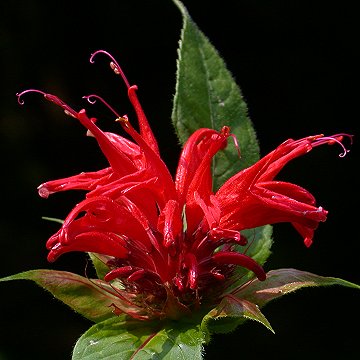

Monarda didyma - (image 1 of 4)
Taxonomy
Family: Lamiaceae
Habitat
Moist woods and thickets. Stream banks. Full sun or part shade.
Associates
Distribution
New England south to GA and west MN to MO.
Morphology
Herbaceous perennial to 1.5 m. Leaves opposite, thin, ovate to lanceolate, acuminate, margin serrate, rounded to broadly acute base. Flowers in terminal, dense heads, subtended by laceolate bracts that exceed the calyx; corollas bright-red to purple, bilabiate, the upper lip narrow and straight, the lower wider and sometimes lobed; calyx tubular, reddish; stamens 2, surpassing the upper lip; style exserted.
Notes
Flowers July to September
Wetland indicator: Facultative + (Upland in the northern Midwest)
The bright red flowers of Oswego tea are irresistible to hummingbirds. Widely planted as an ornamental with cultivars ranging in color from white to pink, red and purple, including hybrids with M. fistulosa. Pictured here is the straight species from a site in central NY. This plant is not drought tolerant and will wilt and eventually die in dry soil. Plants tend to spread, leaving an empty patch in the center, which can be rejuvenated by dividing and replanting. Prone to develop powdery mildew but this does not really harm the plant, only its appearance.
The leaves can be used to make an aromatic tea. This species is also called wild bergamot in reference to the pungent lemony scent of the leaves, reminiscent of bergamot oil. May also be used in potpourris.
References
Gleason, Henry A. and A. Cronquist. 1991. Manual of Vascular Plants of
Northeastern United States
and Adjacent Canada. Second Ed.
The New York Botanical Garden. Bronx, NY
Swink, F. and G. Wilhelm. 1994. Plants of the Chicago Region.
Indiana Academy of Science. The Morton Arboretum. Lisle, Illinois.
USDA, NRCS. 2002.
The PLANTS Database, Version 3.5 (http://plants.usda.gov).
National Plant Data Center, Baton Rouge, LA 70874-4490 USA.
|
Michael Hough © 2005 |